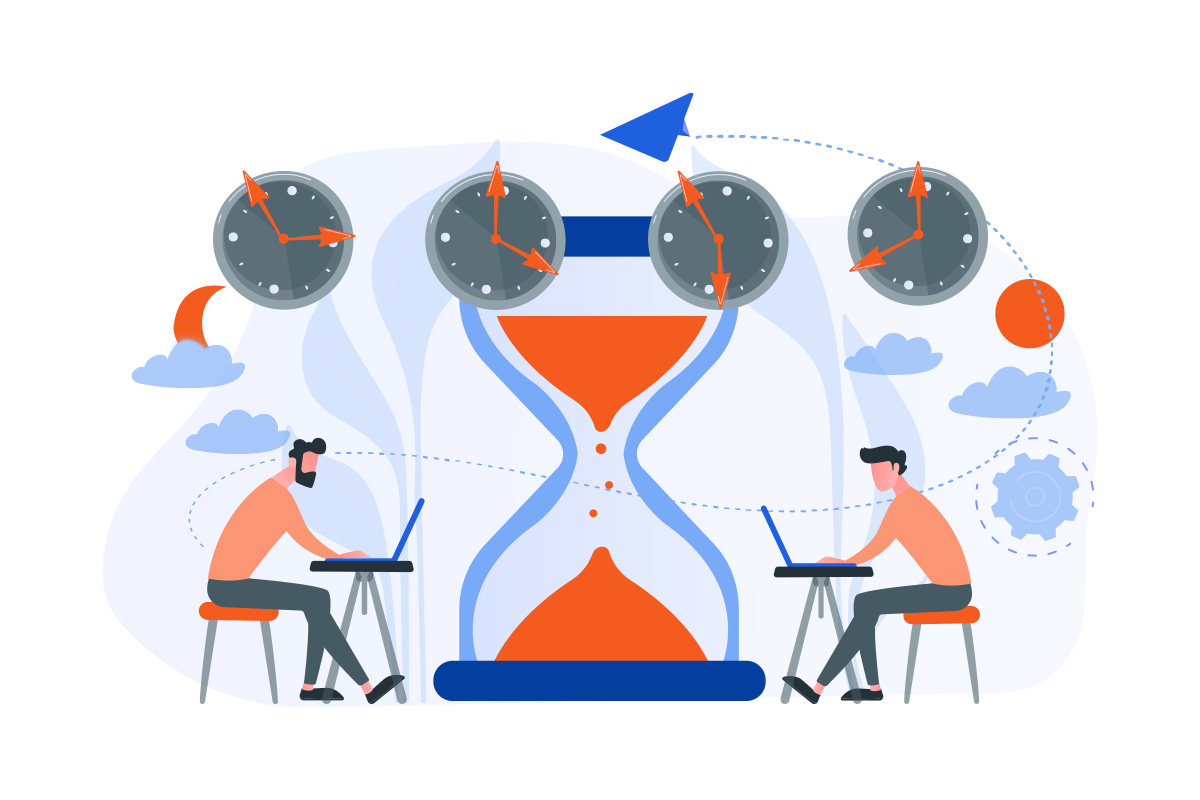The time spent using an electronic device, such as a smartphone, computer, television, or video game console. Screen usage is linked to psychological and physical harm in children’s development. This is because it consumes very little energy. In addition, exposure levels and content influence screen time’s beneficial or harmful health consequences.
What are the screen timing constraints?
Not all timings are created equal. Teens are more self-sufficient, but it is still up to parents to determine how (and how frequently) their children use screens. For example, teens may need to spend more time online doing homework. Still, they may also spend significant time on social media, playing games, or watching television and videos. Screen time should not be used to replace time spent sleeping, eating, exercising, studying, and connecting with family and friends.
- Under 18 months: Screens should be avoided for children under 18 months (besides video chatting).
- 18-24 months: Limit screen usage to occasionally introduce them to instructive items.
- 2-5 years: Limit screen duration to one hour per day for children aged two to five.
- 6+ years: No fixed restriction, but regular limits on media consumption duration, media kinds, and media usage location.
Keep in mind that these figures are only guidelines. Remember that the overarching goal is to develop a positive relationship with screens. Moderation is essential in many aspects of life, and overeating one thing is unhealthy. Cutting back on screen time is a process that won’t happen overnight, so it’s okay if they appear out of reach.

Numerous Methods for Reducing Screen Timing
It may require some effort, but it is possible to eliminate unneeded face time. It will most likely benefit your emotional health as well as your physical health. No matter what you do, whether you put your phone away during meals or quit eating lunch in front of the computer, every minute counts towards decreased screen time. For many people, the desire to play on technology can become a harmful habit that keeps us from being productive and present for those around us. If too much exposure can cause these undesirable habits in adults, it’s not a stretch to conclude that it’s incredibly harmful to a teenager’s developing brain.
Electronic devices might disrupt sleep in the bedroom. It’s better not to bring your phone to bed when it’s time to sleep. Set it to airplane or do-not-disturb mode if necessary; sleep deprivation makes it difficult to maintain energy levels during the day. Keep as many screens as possible out of the bedroom, and by centralizing all devices, you can better control the time spent in front of them.
A television or computer in a child’s bedroom may foster an undesirable habit of falling asleep to the TV or background noise, which may disturb the child’s sleep cycle.
Monitoring the usage of gadget and what it is spent on could be beneficial, as many individuals are clueless about how much time they spend on electronic devices. Let your kids decide how to use their face time once a week once you’ve established an exposure limit. Everyone should avoid using gadgets during meals or within an hour of going to bed. Otherwise, follow through on the arrangement.
It’s critical to establish clear guidelines for when, where, and why your kid can use their gadgets and teach them that utilizing devices for socializing or entertainment is a luxury, not a necessity. For example, allowing screen time only once agreed-upon goals are reached will help your children understand that their access is a privilege.
If it is time to remove a gadget, provide a much better or more appealing move for your youngster! “Tablet time is done, but I’m so happy to play a card game with you!” you might say. Reading, puzzles, board games, playing outside, and spending time with friends or family are just a few healthful activities your family can do instead of using a gadget. Likewise, you can keep your child entertained without a screen by providing new and engaging activities.
Look for activities and clubs that will keep your child socially engaged. With social media and smartphones, much of the socializing that used to occur has been lost. Encourage children of comparable ages to go on outings with them, such as school groups, camps. Participate in non-electronic activities with everyone. Whether playing a board game or going on a family hike, make it clear that no technological devices will be used during your time together.
Advising your teen to turn off his electronics while you’re watching TV is unlikely to be beneficial. Instead, limit your screen time to set a positive example. Unfortunately, children are likely to mimic their parents’ actions. So, if you wish to restrict the usage of gadgets for your children, you should also alter your own. Instead, spend time at home reading, solving puzzles, connecting with family members, or engaging in other non-electronic hobbies.
Although eating lunch at your computer may seem more “productive,” your brain will appreciate the break from the screen. Lunch can be eaten while speaking with family members in the kitchen, gazing out the window, or reading a physical book. Stepping away from technology provides your brain with a vacation and gives your perspective. Go for a stroll, play basketball in the driveway or garden, or do anything else that gets you moving. This break from the digital world helps to renew your mind and create some difference between the end of your professional day and the start of your leisure time. It will be a huge relief to be able to resume more in-person conversations. However, some additional digital burden is unavoidable in the short run.
You might also like: 7 Proven Ways to Deal with Social Media Addiction
Why Is It Critical to Have Less Screen Time?
Excessive screen usage has been linked to an increased risk of conditions such as obesity, diabetes, and sleep issues. In addition, according to research, overusing electronics and social media has also been related to an increase in loneliness and sadness in teenagers. Although some screen time can be informative, excessive exposure can harm a child’s growth and well-being. Excessive screen usage can raise the risk of:
The more screen time a youngster has, the more likely, he will have difficulty falling asleep or keeping a regular sleep routine. This danger is raised if a child watches television before going to bed or if the television is kept in the child’s bedroom. In addition, children who monitor television are more likely to seek items heavy in fat and sugar because they are exposed to advertising for junk food, fast food, and soda.
In addition, children who spend too much time in front of a screen are less likely to be active. Excessive media use can lead to academic challenges, attention problems, hyperactivity, and behavioral disorders.
As previously said, sleep and screen time are significantly influenced by one another and can impact one’s behavior. If a person does not receive enough sleep, it might impair their behavior and performance throughout the day. High levels of screen time can also harm a person’s mental health. With screen usage rising over time, adults have begun to spend an increasing amount of time focusing their attention on displays. This time spent sitting and staring at a device has been related to mental health issues like anxiety and sadness.
Adults who spend six hours or more daily on gadgets are more likely to experience moderate to severe depression. Increased screen time causes an increased risk of depression in adults. With this added danger, lack of sleep plays a significant part in maintaining a healthy attitude, and without adequate rest, mental health can deteriorate faster.
Children’s Screen time has many negative behavioral impacts. The principal effect is a rise in sedentary behaviors. For example, 47% of youngsters spend two or more daily engaged in screen-based passive activities. According to the study, youngsters who spent much time on screens had delayed white matter development, a decreased ability to name items quickly, and low literacy skills. In comparison, 25.5% reported doing at least 20 minutes of physical activity per day for a week.
Furthermore, increasing screen use has been demonstrated to lower a child’s likelihood of partaking in physical exercise. Screen use might also have an impact on interpersonal skills. Screen time releases dopamine, a chemical associated with pleasure, making it difficult for individuals to put down their electronic devices. This implies that when individuals stop using their electronic gadgets, the process of generating dopamine also stops, which might induce irritability in certain people.
The Use of Gadgets and The Internet Endangers Pakistan’s Youth.
The investigation highlighted all the mental and physical issues that had contributed to the deterioration of the lifestyles of children and teenagers due to their excessive usage of social media. This also threatens Pakistan’s future because excessive use of social media tarnishes the youth’s skills, mentality, and routine. The child of any country is the essential part because they are the ones who will have to run the country soon, and no government can prosper with an unskilled, poorly trained, and unorganized set of people. Teenagers spend an average of 7-8 hours daily on social media, which is the primary factor contributing to a lack of productivity.
The study’s overall goal was to make people aware of the catastrophe caused by this unforeseen circumstance in the country and the ramifications it would have to deal with shortly. But unfortunately, social media has also contributed to the spread of vulgarity in Pakistan.
Reduce Your Screen Time Using Technology
Technological gadgets are handy, convenient, and entertaining. Fortunately, instruments are available to aid you in managing your screen time.
Screen Time is screen-time monitoring and limit-setting tool included straight into the settings of every iPhone and iPad. Go to your iOS device’s settings to find it. (To get the most recent features, make sure you’re running the most current version of iOS.)
You can observe how long you use each app and set daily limitations for individual apps with this built-in function. For example, if you have a TikTok addiction, you can limit your usage to one hour daily. You will no longer be able to approach TikTok after you have reached the limit. You may disable the limit by entering your passcode, but activating Screen Time should help reduce it.
Digital well-being is Google’s answer to Apple Screen Time. You may set time limitations for individual apps in Digital Wellbeing. You can also track how much time you spend on each app and how many times you unlock your phone. So screen time-restricting technology is also present in android.
The key message is that there are solutions for limiting screen time: Google and Apple cellphones already include screen-time monitoring and restricting functions. You can also arrange time limits for your device to access your home Wi-Fi if you need a firm boundary.
If these two options seem harsh and you only want a friendly periodic reminder to watch your screen usage, ask your Alexa or Google Home device to remind you to take a screen break every couple of hours. Though it may appear paradoxical, technology can assist you in limiting your screen time.
Final Words
Reducing screen time and establishing limits does not simply revolve around screen time; it is a complete lifestyle that the student and family must adapt. Remember that this will not happen overnight; it will take weeks to settle into a habit. The ideal technique is to begin by limiting the time and gradually lower it to the time range you have set.
Arrange for some painting and craft activities or outdoor games; this will keep the child engaged and help drain the energy. On other days, participate in cooking tasks with them and allow them to design the cupcakes. The goal is to help kids enjoy activities other than watching television or using electronic devices. Allow them to have cheat days on weekends and to stay up late while you watch a movie together.




